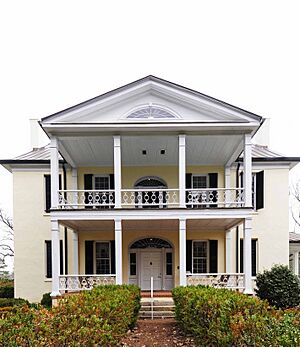Rose Hill Plantation State Historic Site facts for kids
Quick facts for kids Rose Hill Plantation State Historic Site |
|
|---|---|

Rose Hill
|
|
| Nearest city | Whitmire, South Carolina |
| Area | 44 acres (0.18 km2) |
| Created | 1960 |
| Website | http://www.southcarolinaparks.com/park-finder/state-park/540.aspx |
|
Rose Hill
|
|
| Lua error in Module:Location_map at line 420: attempt to index field 'wikibase' (a nil value). | |
| Area | 44 acres (18 ha) |
| Built | 1832 |
| Architect | William H. Gist |
| NRHP reference No. | 70000605 |
| Added to NRHP | June 5, 1970 |
Rose Hill Plantation State Historic Site is a special place in Union County, South Carolina. It protects the old home of William H. Gist, who was the 68th governor of South Carolina. Governor Gist was involved in important events that led up to the American Civil War.
Contents
Welcome to Rose Hill Plantation
Rose Hill Plantation is a historic site that lets visitors step back in time. It was once a large farm and the home of a powerful governor. Today, it helps us understand a significant period in American history.
The Story of the House
The main house at Rose Hill was built a long time ago, between 1811 and 1830. It was first designed in a style called Georgian architecture. This style was popular for its balanced and classic look. The house was named Rose Hill because of the many beautiful roses planted in its gardens.
From Georgian to Greek Revival
Later, in the late 1850s and early 1860s, Governor Gist updated his home. He added grand porches to the front and back. He also covered the brick with a smooth finish called stucco. This changed the house's look to the more fashionable Greek Revival architecture style.
The finished house had three floors. The first two floors were for living, and the third floor had both living and storage areas. The house had fancy decorations, which were quite special for homes in that area at the time. A beautiful spiral staircase led to the second floor. This floor even had a large room that could be used as a ballroom. It had two fireplaces, so it could be divided into two bedrooms for guests.
A Governor's Home and Important Decisions
From 1858 to 1860, Rose Hill served as the governor's official home. During this time, Governor Gist wrote letters to other state governors. He suggested that if Abraham Lincoln became president, South Carolina might choose to leave the United States. This idea was called "secession" and was a major cause of the Civil War.
Life on the Plantation
Rose Hill was a large working farm, covering about 2,000 acres. On this land, people grew crops like cotton, corn, and oats. Many people, known as enslaved laborers, were forced to work on the plantation. They did not have their freedom. For example, in 1860, about 178 enslaved people lived and worked at Rose Hill. After the Civil War ended, slavery was abolished. The plantation then relied on tenant farmers and sharecroppers to work the land.
Rose Hill Through the Years
Governor Gist passed away in 1874. His family kept the house and land for some time, though they rented it out. In 1938, the US Forest Service bought Rose Hill. It became part of the Sumter National Forest.
Later, in 1942, a man named Clyde T. Franks bought the house and 44 acres. He was an antique collector and loved old things. Mr. Franks worked hard to restore the house and its gardens. He also filled it with furniture from that time period. In 1943, he opened Rose Hill to the public. Finally, in 1960, Mr. Franks sold the property to the South Carolina State Park Service.
Visiting Rose Hill Today
Today, Rose Hill Plantation State Historic Site welcomes visitors. You can find restrooms, a picnic shelter, and a small gift shop there. An old brick kitchen, built in the 1850s, is another historic building on the property. The exact location of where the enslaved people lived is not known. There is also a nature trail, about one and a quarter miles long. It goes through the park and into the nearby forest, leading to the Tyger River. The Gist family cemetery is about one mile south of the main house.

